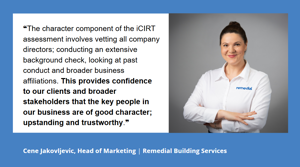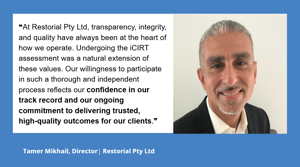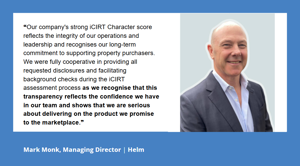What “Good Looks Like” for iCIRT Ratings
4 June 2025
Understanding the criteria for a favourable iCIRT ‘Character’ assessment.
An iCIRT rating recognises the multifaceted elements that distinguish high-trust property development and construction companies. But what does this look like in practical terms?
This article is the first in a series designed to explain the iCIRT assessment process and illuminate 'What Good Looks Like' for businesses aspiring to achieve a strong rating. An iCIRT rating is the result of an objective and independent assessment across six critical pillars: Character, Capability, Conduct, Capacity, Capital, and Counterparties.
We begin with ‘Character’.
Why these six pillars? The foundation of trust
iCIRT was designed to support and improve transparency, offering property buyers and the market independent information to build confidence as to who they can trust. It was developed with input from government agencies, industry bodies, market associations and consumer groups to create a rating system that measures the capability, reliability, and resilience of construction professionals.
The diverse concerns and positive indicators identified through this collaboration were distilled into six ‘C’ pillars, closely mirroring the ‘5 Cs of credit’ due diligence framework used by financial institutions. This alignment ensures the iCIRT assessment criteria are broadly understood and accepted as robust indicators of a business's overall health and reliability. ‘Character’, in particular, is a foundational element in credit evaluation and integral to Know Your Client (KYC) checks prevalent in many industries.
iCIRT rated Remedial Building Services achieved a strong ‘Character’ assessment score, reflecting their commitment to transparency and building trust.

Defining 'Character': who is really behind the business?
When iCIRT assesses a company's 'Character', it delves into the individuals driving the business. A crucial differentiator of the iCIRT assessment is its focus not just on formally appointed ASIC officeholders, but on anyone influencing decision-making.
Key aspects under scrutiny include:
- The real influencers: iCIRT looks beyond titles to identify key persons who commercially, financially, or operationally influence business outcomes. This includes identifying ‘shadow directors’ – individuals who may exert significant control without formal appointment. The expanded line of sight provides a deeper assurance of trustworthy behaviour, ensuring key personnel possess the requisite experience, capability and credentials, and have not been involved in fraud, criminal activity or personal bankruptcy.
- Track record: Extensive background checks of key persons are conducted. This involves verifying employment history and credentials like trade qualifications, licensing, degrees and ongoing training. The assessment considers both their operational expertise and commercial track record, including a demonstrated capacity for effective project oversight and sound business governance.
- Past conduct: The iCIRT assessment actively seeks red flags among key individuals, such as previous insolvencies (especially those indicative of phoenixing), bans or disqualifications, involvement in enforceable undertakings, disciplinary actions or prohibition penalties.
- Broader business affiliations: The review extends beyond the corporate structure to examine other business affiliations key personnel may have, such as their own private businesses, partnerships or joint ventures, to ascertain whether they have previously caused harm.
Essentially, the 'Character' assessment aims to provide confidence that the individuals behind a business are reputable, experienced, and operate with integrity.
iCIRT rated builder, Restorial Pty Ltd, achieved a strong ‘Character’ assessment score, reflecting their commitment to transparency and building trust.

How to strengthen your 'Character' profile for an iCIRT rating
Businesses seeking a strong score in the 'Character' iCIRT assessment can take proactive steps. Here’s “What Good Looks Like”:
Transparency and full disclosure:
A willingness to be open is paramount. This means readily providing requested information, consenting to comprehensive background checks and being transparent about your business affairs, past performance and related parties.
A management team with bench strength:
Demonstrate that roles and responsibilities are clearly delegated across various individuals, so business success isn’t solely reliant on one person. Ensure the management and project delivery team can illustrate their teamwork, capability and collective leadership.
Key people have demonstrable experience and expertise:
Detail projects each key person has managed, their specific roles, responsibilities and involvement duration. This documented history allows iCIRT to verify their track record on past projects, being aware of any prohibitions, ratifications or adverse findings. The iCIRT assessment process enables new businesses to achieve a strong ‘Character’ score by showcasing the positive historical experience of its key personnel in project design, development, delivery, assurance and commercial acumen, including contracting, governance and financial oversight.
Demonstrate personal commitment to the business:
For businesses that might be thinly capitalised or are pursuing aggressive growth, show that the people behind the business are personally invested in its success and obligations. This could be through an indemnity in a personal deed, or pledging assets in group trading agreements. Commitments like these demonstrate a strong vote of confidence in the business’s viability and obligations.
What If your corporate structure is complex?
iCIRT recognises that many businesses employ complex corporate structures, including Special Purpose Vehicles (SPVs), and does not penalise complexity itself.
However, ambiguity or where there is a lack of transparency surrounding ownership and connectedness of these structures, may be a key concern. For businesses with legitimate past restructures, 'What Good Looks Like' is a transparent, well-documented structure providing clear evidence of responsible conduct:
- Clarity is key: Businesses should provide a clear corporate structure diagram, identify all related parties, and transparently outline any transactions, deeds, guarantees, or support contracts between these entities.
- Defined roles: An organisation chart detailing roles and responsibilities across different entities within a complex group is highly beneficial.
- Legitimate purpose: Documentation should demonstrate the structure serves legitimate operational purposes to address market concerns around some simply seeking asset protection.
- Honouring obligations: Demonstrate that statutory or contractual obligations from previous entities (especially concerning defects or warranties) have been properly novated or transferred to the current or another enduring entity.
- Sufficient capitalisation: Businesses should demonstrate their commitment to maintaining adequate capital to ensure entities are equipped to honour their ongoing responsibilities and commitments.
iCIRT rated developer, Helm, achieved a strong ‘Character’ assessment score, reflecting their commitment to transparency and building trust.

What are the indicators of phoenixing activity?
The regulated credit rating agency Equifax Australasia Credit Ratings Pty Ltd (Equifax) conducts the independent data analysis and insights that inform the iCIRT rating outcome. Equifax, a global data, analytics and technology company, has operated in Australia for over 50 years.
As Australia’s leading information broker, commercial bureau, consumer bureau, and provider of background checks and counterparty risk services, Equifax is uniquely positioned to observe if business operators are using personal finance to support their business. Also whether indicators of emerging financial stress exist.
Some indicators of phoenixing include:
- Past instances of financial distress, whether personal or related to prior businesses, associated with shadow directors or other key persons of influence.
- The establishment of newly formed businesses with clear links to individuals or entities previously associated with financially distressed or failed companies.
- A pattern of transferring assets from an indebted company to a new company, leaving debts with the old entity without having the resources to honour those obligations.
How important is record-keeping?
External administrators consistently report cash flow, profitability and governance as the top three issues influencing business failure. Robust record-keeping signifies good governance.
Businesses retaining documentation evidencing their operational, financial and controls environment are well-positioned not just for operational success but also to move the dial towards a favourable iCIRT rating outcome. A lack of records or a reluctance to share business information inevitably raises questions and can negatively impact the assessment.
Businesses should be prepared to disclose:
- ✓ Primary personnel (for key person checks): Provide contact details of your critical personnel to initiate the background screening process.
- ✓ Operations: Team structure, organisation chart, services/specialisation, oversight and experience. Business plans and records of staff recruitment, induction, oversight and ongoing professional development.
- ✓ Projects: Current & past project details.
- ✓ Controls: Group structure, contracts, quality assurance, project and risk management systems, insurance and claims.
- ✓ Financials: Three years of financial statements, recent interim accounts, funding facilities, revenue projections, valuations, guarantees, inventories, debtors and creditors.
- ✓ Conduct: Responses to legal, regulatory and statutory obligations. Outline your business response to disputed issues, if applicable, over the past 24 months.
By focusing on these elements of 'Character', businesses can improve their iCIRT rating prospects and demonstrate how they are fostering a culture of integrity, capability and accountability. This, in turn, builds essential trust with property buyers, partners and the wider community for long-term success.
Stay tuned for our next article in this series, where we will delve into the 'Capability' pillar of the iCIRT assessment.
*Excerpts of this article have been taken from the original news story featured in www.equifax.com.au/knowledge-hub/what-good-looks-icirt-ratings
